
Do Not Fear the Sailor 'Jellyfish' Invasion
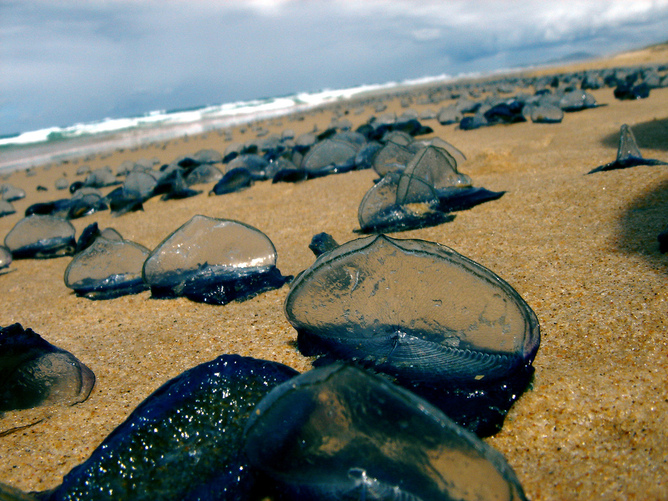
This article was originally published on The Conversation. The publication contributed this article to Live Science's Expert Voices: Op-Ed & Insights.
Billions of small, jellyfish-like creatures known as “by-the-wind sailors” have washed ashore all along the west coast of North America this summer, from southern California to British Columbia. Images of vast swarms of electric-blue sails covering the ocean’s surface and littering the sand are indeed spectacular, but people might well wonder what exactly these strange-looking beings actually are. And this of course leads to the next question – should we be afraid of them?
Velella velella (to give them their scientific name) are often assumed to be a type of jellyfish but, while biology does lump them in with jellyfish, sea anenomes, and corals in a group known as Cnidaria, Velellas are not all that closely related to the common or moon jellyfish, Aurelia aurita.
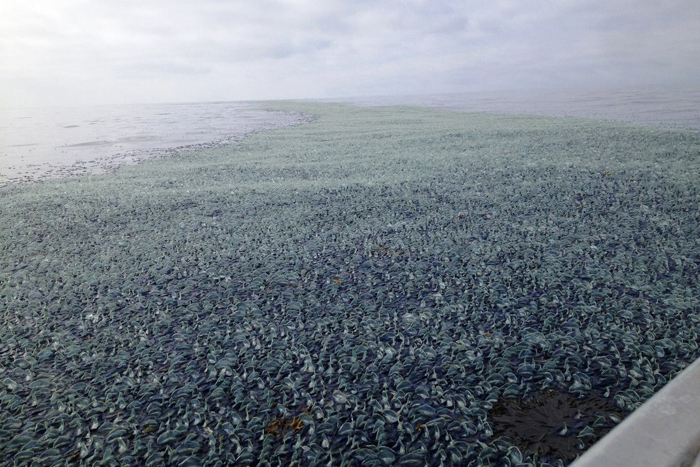
Cnidarians have two body forms: the umbrella-shaped, tentacle-trailing “medusa”, your classic jellyfish; and “polyps” such as seas anemonies that typically live attached to the seabed. Velella is a colony of specialised individual polyps, much like their fellow sailors the Portuguese Man o' War. Instead of living attached to rocks on the seabed, the water surface has become its substrate.
The by-the-wind sailor’s body is a flat oval disk 6-7 cm in diameter containing a series of air-filled chambers that provide buoyancy. Below hangs a central mouth surrounded by specialised reproductive bodies that produce tiny medusae, little “jellyfish”, and stinging tentacles – which are harmless to humans.
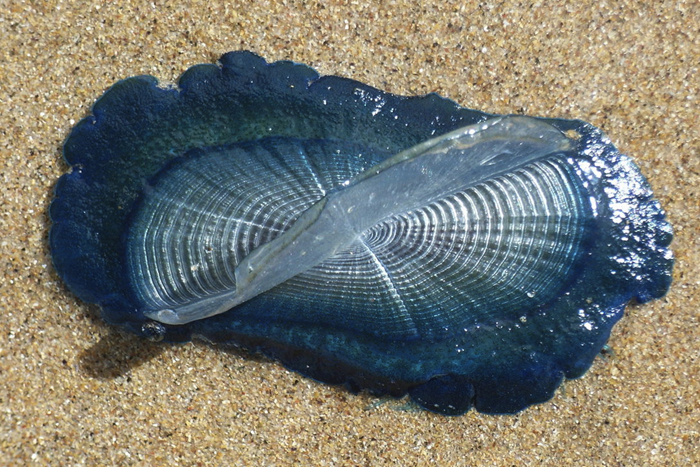
Projecting vertically up is a stiff translucent triangular vane made of chitin, a substance derived from glucose that is also used in crab and insect skeletons or squid beaks. This vane acts like a small sail. Interestingly, the sail runs diagonally across the top of the float, so that the individual sails at a 45 degree angle to the prevailing wind, just like a sailing boat.
Another striking feature is the bright blue colour, which is thought to serve as camouflage and/or protection from the sun’s rays. Animals that wash up on the beach dry up and become bleached white within a day or two.
Sign up for the Live Science daily newsletter now
Get the world’s most fascinating discoveries delivered straight to your inbox.
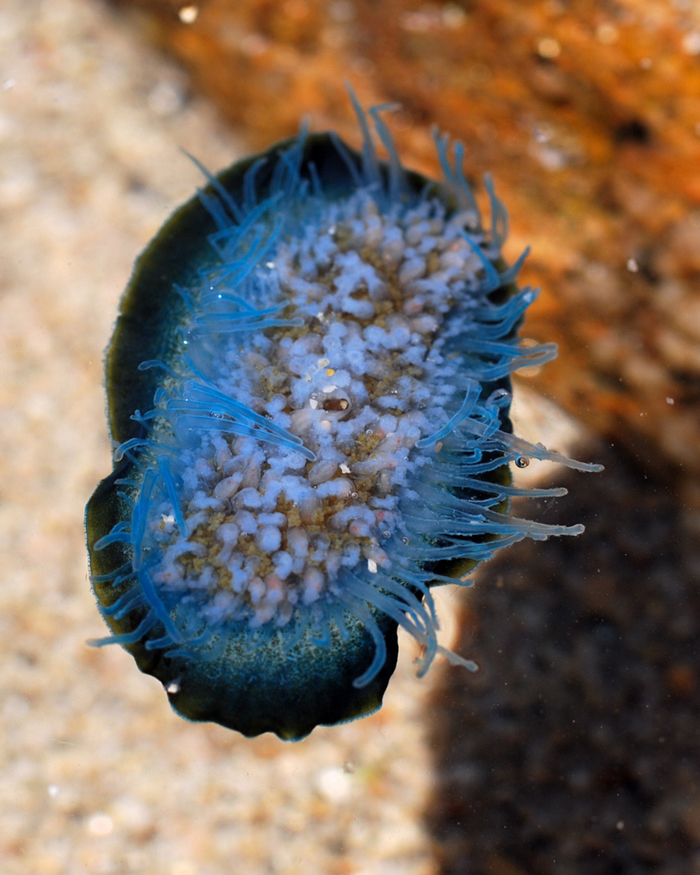
Velella velella use their stinging tentacles to capture and feed on small fish larvae and zooplankton – microscopic animals that drift in the sea. But this is not their only source of food. If you look closely, you will also see a golden-brown colour inside the tissues which are zooxanthellae – symbiotic photosynthetic microalgae – that provide the host animal an additional source of nutrition.
By-the-wind sailor is a very common open ocean organism, living in warm to warm-temperate waters throughout the world’s oceans. It is thought that there is a difference in preferred sailing direction in the northern and southern hemispheres, and on the eastern and western shores of oceans, but this has been hard to prove.
Nevertheless, research suggests that California Velella have a sail which is angled to the right of the main axis. This means that as the wind pushes it along, Velella tacks to the right of the northwesterly prevailing wind and so these animals are usually kept offshore. Occasionally winds come from the southwest so that populations get blown ashore, as in the recent cases in the US.
Similarly, there have been years when large numbers were blown onto the southern coast of the UK, particularly following strong southwesterly winds blowing off the Atlantic.
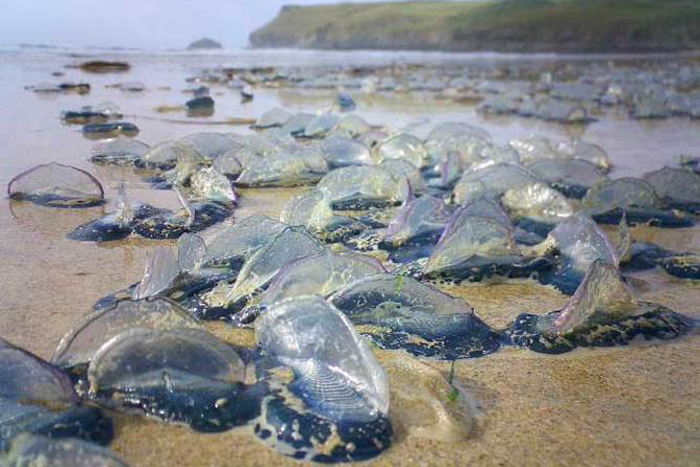
The fact is that every spring and summer, millions of these strange creatures are blown ashore on the west coast of America. But this year, the numbers have been much greater and the strandings even more impressive.
One reason for this is that storms in the eastern Pacific are likely to have blown the Velella on to the beaches. California’s beaches recently saw their largest swells since 1997, as surfers rode monster waves caused by tropical storms hundreds of miles out to sea.
Warmer waters associated with a build up to an El Niño year could have stimulated greater production of new baby Velella out in the mid ocean. Jellyfish and their relatives are all very flexible and are able to rapidly take advantage of favourable conditions. They are relatively short-lived, less than a year, can grow and reproduce very quickly, and produce large numbers of offspring. Therefore when conditions are ripe – waters are warm and food is plentiful – their numbers can suddenly erupt.
The occurrence of “good years” and “bad years” is common across all jelly-like creatures. This year in the UK, for instance, there have been reports of large numbers of Barrel jellyfish sightings along the southwest coast. While this is not unique, certainly these sorts of numbers had not been recorded in that part of the English Channel for a considerable number of years. Like Velella velella, barrel jellyfish mainly live offshore, and it is thought that the very warm spring and early summer coupled with altered water currents enabled large numbers to move in closer to land.
In the Bering and North Seas, where scientists have recorded jellyfish numbers over time, we know that fluctuations have been caused by changing sea temperatures, food availability and long-term climate cycles. At a global scale, analysis carried out by researchers in the Global Jellyfish Group has also revealed large-scale oscillations in the presence of jellyfish and jellyfish-like creatures over the decades. It’s a boom and bust existence.
Many are worried that these “jellyfish” blooms are likely to become more common as a result of human-induced climate change, and there may be some truth in this. Huge blooms of giant jellyfish in Japan, or the mauve stinger in the Mediterranean, have indeed become more frequent in recent years, harming tourism, fisheries and aquaculture, and power plants (jellyfish have a habit of clogging up nuclear reactor cooling pipes). But this is not a universal trend; jellyfish aren’t about to take over the world, and neither are their sailor cousins.
Cathy Lucas has received funding from the National Centre for Ecological Analysis and Synthesis (NCEAS) based in Santa Barbara, USA for work carried out on the Global Jellyfish Blooms Project and the creation of the Jellyfish Database Initiative (JeDI).
This article was originally published on The Conversation. Read the original article. Follow all of the Expert Voices issues and debates — and become part of the discussion — on Facebook, Twitter and Google +. The views expressed are those of the author and do not necessarily reflect the views of the publisher. This version of the article was originally published on Live Science.









